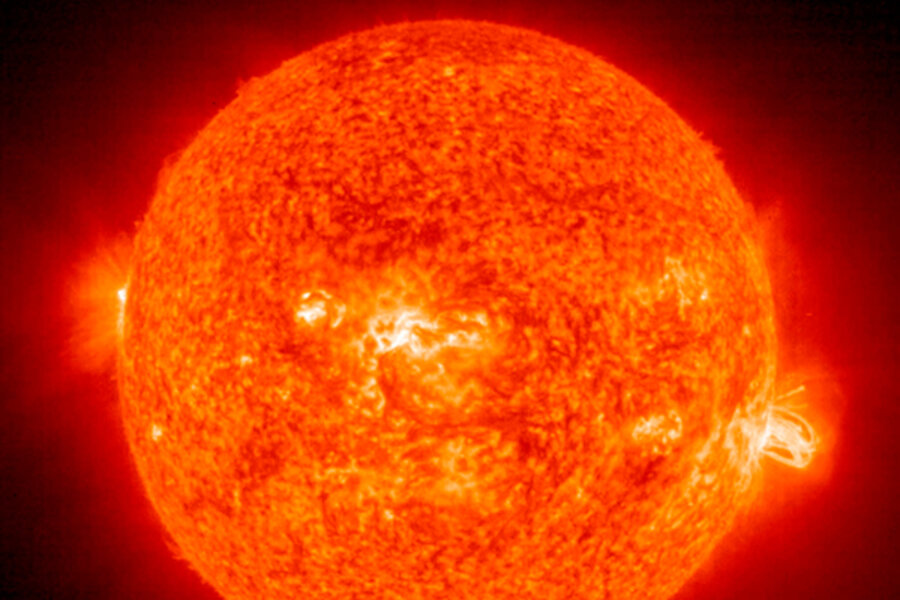A sun with no sun spots? What that could mean for Earth and its climate.
Loading...
Sun spots appear to be teetering on the verge of vanishing from the surface of the sun – perhaps for several decades.
That's one possibility raised by three independent studies unveiled Tuesday at a solar-physics meeting in Las Cruces, N.M.
If the trends the studies highlight hold, the researchers say, a sun humbled by changes in its own internal workings could produce fewer solar storms during a prolonged quiet period – good news for satellite operators, astronauts, and Earthbound utility companies that must keep solar storms from triggering blackouts.
A long quiescent period also could provide an unexpected, natural laboratory for investigating often-discussed but poorly explored links between sunspot activity and global climate.
The most oft-cited example of a shutdown in sun spots is the so-called Maunder Minimum, a 70-year period that began around 1645. Sun spots virtually vanished from the sun's surface. The decline coincided with a climate period known as the Little Ice Age, when temperatures fell substantially in various locations around the globe and different times during the time span.
Researchers have been looking at this correlation with an eye toward figuring out whether and to what extent seemingly small fluctuations in sunlight that come with changes in the sunspot cycle may affect Earth's climate.
"I have not seen enough evidence either way to say whether solar activity is responsible for climate effects or not," says Frank Hill, an associate director with the National Solar Observatory in Tucson, Ariz., who led one of the studies.
But "if the next solar cycle, Cycle 25, does not occur, we'll have a splendid opportunity to find out," he adds.
On the other hand, he offers, scientists may merely be watching another cycle with a delayed onset, similar to the run-up to the current sun-spot cycle, which started more than a year late.
What are sun spots?
Sun spots are relatively cool regions of hot gas on the sun's surface, prevented by intense magnetic fields from plunging back into the depths of the sun for a reheat. These spots wax and wane in a cycle that averages 11 years.
During the peak of the cycle, the sun is at its most active, generating flares, prominences, and unleashing the granddaddies of solar outbursts: coronal mass ejections (CMEs).
All of these can occur at any time during the solar cycle, but they are most frequent during its peak.
Last week, for instance, the sun unleashed an enormous mass of charged particles in a coronal mass ejection that struck Earth a glancing blow. still, it triggered auroral displays closer to the equator than usual and anxious moments for utility-grid and satellite operators.
Evidence for a potential long-term slowdown or even halt to sun spots for a period come through three sets of measurements.
Drawing on 13 years of sun-spot data, National Solar Observatory researchers Matt Penn and William Livingston have documented a consistent decline in the strength of the magnetic fields associated with sun spots. If the strength of those fields drops below a certain level, the spots vanish.
If the decline in magnetic-field strength continues at its current pace, Dr. Penn says, the current solar cycle, Cycle 24, will be half a strong as the last one.
"Cycle 25 may have no sun spots at all," he adds.
Hill's group at the National Solar Observatory used measurements of the sun's acoustic signals to gauge the movement of high-speed jet streams of solar material inside the sun's northern and southern hemisphere. These jet streams tend to form at high latitudes and migrate toward the equator over the course of a sun-spot cycle. And they tend to be the spawning grounds for sun spots.
Typically, new jets, the foundations for a new sun-spot maximum, form even before the existing jets reach the equator and vanish, Hill explains. The new jets should have started forming in 2008. They have yet to appear.
A rush to the poles
Finally, a team led by Richard Altrock, who heads the US Air Force's corona research program, used 40 years of data to track how magnetic structures in the sun's corona – its outer atmosphere – "rush to the poles" on the sun toward the end of a solar cycle.
This "rush" typically starts at around 70 degrees latitude on the sun at the start of a solar cycle, with the new magnetic structures forcing the leftovers of the old cycle to migrate toward the sun's poles.
The current solar cycle saw this migration begin late and take place slowly, suggesting the new fields may not be strong enough to keep the old ones moving. Indeed, the older structures themselves for this cycle look weaker than their predecessors.
Hill notes that the weakening may provide further evidence of an 80- to 90-year sun-spot cycle, in which the 11-year cycle is embedded.
One of these "grand minima" occurred between 1460 and 1550, while another appeared between 1790 and 1830. Given the margins of error in those time estimates, if the sun's slowdown continues, it could be the latest in a line of these grand minima, during which solar activity drops dramatically, even at the peaks of the solar cycle, but sun spots still appear.
Whatever happens, "it's more information that can be used by people who do the theory of how this all works," Hill says.
Researchers have much yet to learn about how the sun works – the basis for understanding stars in general.
Theorists "have not really touched the problem of grand minima yet," Hill adds.





